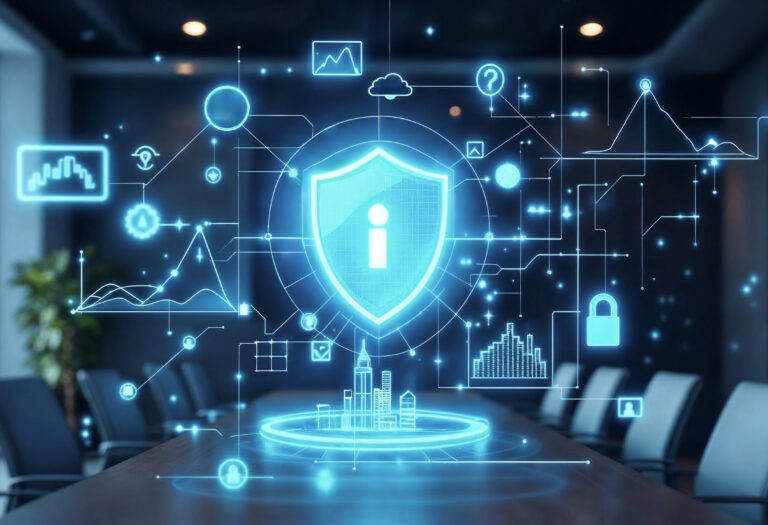Introduction
In today’s digital landscape, cyber threats—from ransomware to phishing—are constant and evolving. For IT leaders and executives, simply responding to these threats reactively is no longer sufficient. A structured cybersecurity risk management process is the cornerstone of a proactive, resilient, and compliant security posture.
Research indicates that organizations with formal risk programs experience significantly fewer breaches and recover faster. This process aligns security priorities with business goals, ensuring that limited resources are used effectively and that executive teams can make informed decisions.
This guide walks through definitions, processes, best practices, and real-world examples. Whether your organization is starting from scratch or refining its approach, this structured roadmap—augmented by a trusted partner like Infodot—delivers clarity, readiness, and confidence in the face of cyber risk.
What Is Cybersecurity Risk Management?
Cybersecurity risk management is a strategic, ongoing process that aligns technology, processes, and people to identify, assess, treat, and monitor risks to critical systems. By converting abstract threats into tangible actions, it enables informed decision-making and drives continuous improvement in organizational resilience.
- Defines risk appetite and thresholds for exposure
- Enables consistent business-aligned control selection
- Provides a governance model for accountability
- Supports budgeting based on quantified risk
- Fosters cross-functional collaboration
- Integrates compliance with risk decisioning
- Enables formal documentation of decisions
- Drives continuous security posture improvement
The Cybersecurity Risk Management Process: Step-by-Step
A structured lifecycle guides organizations from inventory to evaluation, treatment, and reassessment. This repeatable process ensures risks are continuously managed and aligned with evolving threats and business needs.
1. Asset Inventory
Compile hardware, software, data, and personnel to understand what needs protection.
2. Risk Identification
Identify potential threats and vulnerabilities that could impact your assets.
3. Risk Analysis
Assess likelihood and business impact of identified risks using quantitative or qualitative methods.
4. Risk Evaluation
Compare risks against risk appetite and priorities to determine which need immediate attention.
5. Risk Treatment
Apply controls or transfer/accept risk based on cost-benefit analysis and organizational capacity.
6. Monitoring
Continuously track controls and threat environment for changes and effectiveness.
7. Reporting
Provide metrics for leadership and board to support decision-making and accountability.
8. Reassessment
Adjust based on incidents or changes in business environment, technology, or threat landscape.
Best Practices in Cyber Security Risk Management
Following proven practices ensures that your cyber risk program remains effective, scalable, and audit-ready while aligning to global standards. These practices also align with various types of audit in cyber security, helping ensure organizations stay compliant.
- Adopt structured frameworks like NIST or ISO 27001
- Involve executive leadership and board oversight
- Maintain a dynamic, up-to-date risk register
- Conduct regular penetration tests and red-teaming
- Apply layered defense across people, process, tech
- Use quantitative scoring (e.g. FAIR, CVSS)
- Provide training and awareness for staff
- Employ independent audits for unbiased review
Benefits of a Well-Managed Risk Management Process
An effective risk management program delivers concrete business value: reduced breaches, faster incident response, lower costs, and stronger stakeholder confidence.
- Fewer disruptions from cyber incidents
- Lower breach and remediation costs
- Improved compliance and audit outcomes
- More accurate cybersecurity budgeting
- Enhanced investor and customer trust
- Reduced cyber insurance premiums
- Strengthened incident response maturity
- Ongoing enhancement of security posture
Challenges in Managing Cyber Security Risks
Risk management offers substantial benefits, but common challenges include limited visibility, overwhelming alerts, and evolving threats that can strain resources and infrastructure.
- Incomplete asset inventory hinders risk tracking
- Alert fatigue affects analyst efficiency
- Talent shortages slow security operations
- New threats emerge faster than controls
- Conflicting regulatory requirements complicate compliance
- Shadow IT increases unknown risk
- Third-party risk from vendors
- Budget constraints limit program expansion
How to Mitigate Cybersecurity Risks?
Mitigating cyber risk requires integrated technical defenses, strong governance, and ongoing training—all tailored to your organization’s context and risk appetite.
- Deploy multi-factor authentication (MFA)
- Ensure timely patch and configuration management
- Implement Endpoint Detection & Response (EDR)
- Encrypt data in transit and at rest
- Segment network based on risk and function
- Conduct regular employee security training
- Backup critical assets with tested recovery
- Maintain robust incident response plans
Top 10 Cybersecurity Risks
Understanding prevalent risks empowers organizations to prioritize and defend against the most likely and impactful vulnerabilities.
1. Phishing and Spear-Phishing
Targeting high-value staff with deceptive communications to steal credentials or install malware.
2. Ransomware Attacks
Malicious software that encrypts data and systems, demanding payment for restoration.
3. Insider Threats
Privilege misuse by employees, contractors, or business partners with legitimate access.
4. Legacy/Unpatched Software
Exploitation of known vulnerabilities in outdated systems and applications.
5. Cloud Misconfiguration
Improperly configured cloud services exposing sensitive data or resources.
6. Shadow IT
Unmanaged technology solutions introducing unknown risks to the organization.
7. IoT/OT Vulnerabilities
Security weaknesses in Internet of Things and operational technology devices.
8. Credential Stuffing Attacks
Using stolen username/password combinations to gain unauthorized access.
9. Zero-Day Exploits
Attacks targeting previously unknown vulnerabilities in core platforms.
10. Third-Party Supply Chain Compromises
Security breaches through vendors, suppliers, or service providers.
Risk Management Framework for Cybersecurity
Well-established frameworks provide structured methodologies, benchmarks, and compliance pathways, minimizing redundancy and aligning with global best practices.
- NIST CSF: Identify, Protect, Detect, Respond, Recover
- ISO/IEC 27001: Standardized information security management
- CIS Controls: Tactical defense rule sets
- FAIR Model: Quantitative risk analysis method
- COBIT: Governance-focused framework
- SOC 2: Service provider trust standard
- PCI DSS: Payment card-focused requirements
- HIPAA: Regulates healthcare data security
How to Pre-empt Cybersecurity Risks?
Proactive risk management anticipates threats before they surface—requiring visibility, automation, and simulation.
- Use threat feed integration in SIEM
- Run ongoing threat hunting campaigns
- Automate incident orchestration and response
- Perform scheduled red/blue team exercises
- Scan the dark web for credential exposure
- Apply Zero Trust access models
- Deploy AI-based anomaly detection
- Enforce secure configuration baselines
CISO-as-a-Service for Risk Oversight
An MSP-delivered CISO function offers strategic leadership, board insights, and alignment of cyber risk with business objectives.
- Provide virtual CISO expertise
- Conduct executive risk dashboards
- Manage compliance alignment
- Drive culture of security
- Offer incident advisory
- Engage external audits
- Oversee policy development
- Mentor internal security teams
Managed Third-Party Vendor Risk
Third-party connections frequently introduce exposure. MSPs help assess vendor maturity and enforce secure integration.
- Audit vendor cyber posture
- Monitor supply chain risks
- Enforce secure contracts
- Control vendor network access
- Validate third-party audits
- Track vendor incidents
- Schedule vendor reviews
- Automate vendor risk scoring
Risk-Aware DevSecOps Integration
Secure development integration enables teams to remediate flaws early, reducing production vulnerabilities.
- Embed SAST and DAST tools
- Automate pipeline security checks
- Train developers in secure coding
- Manage dependency risk
- Track build-time vulnerabilities
- Enforce branch protections
- Flag high-risk commits
- Monitor runtime behavior
Cyber Insurance Readiness & Claims Support
MSPs align controls with insurer expectations, provide audit evidence, and assist with claims to maximize coverage.
- Map controls to policy requirements
- Perform pre-insurance assessments
- Provide evidence for underwriters
- Activate support during incidents
- Coordinate forensic investigation
- Document remediation actions
- Engage with insurers post-breach
- Streamline claim submissions
Why Choose Infodot for Cybersecurity Risk Management
Infodot delivers full-spectrum cyber risk management—pairing expertise in frameworks, technology, and compliance. We help build resilient programs that align with executive strategy and scale with growth. Our services also cover aspects of managed cyber security services for complete risk handling.
- 24×7 monitoring and alerts
- Virtual CISO services
- Risk assessments with benchmarks
- Continuous compliance support
- Vendor risk management
- Incident response coordination
- Executive-level dashboards
- Scalable solutions for all sizes
Real-World Examples
Real-World Example 1: Financial Institution Halts Ransomware
A mid-sized bank was hit by ransomware targeting transactional systems. Without a clear risk management process, response was slow—leading to downtime and regulatory fines. Infodot helped implement continuous risk scoring, EDR, and a tested incident response playbook. When ransomware landed weeks later, systems automatically isolated, and backups restored within hours—avoiding service disruptions and protecting customer trust. Quarterly risk reviews ensured the bank stayed ahead of emerging threats. This scenario also highlighted the importance of a periodic cyber security audit.
Real-World Example 2: Healthcare Network Stops Phishing Breach
A regional healthcare provider faced frequent credential‐based phishing attempts. With no centralized risk process, attacks often reached privileged systems. Infodot established asset mapping, applied MFA, and deployed phishing simulations. Dark-web credential monitoring alerted suspicious leaks, resulting in forced password resets. These actions prevented multiple breaches. The organization now conducts quarterly tabletop exercises and shares risk dashboards with its board. Reduced phishing success rates and HIPAA compliance improvements followed, reinforcing patient data protection. The role of AI in cyber security was essential in proactively identifying phishing anomalies.
Conclusion
A mature cybersecurity risk management process is no longer optional—it’s essential in today’s threat landscape. Reactive defenses leave gaps vulnerable to exploitation, while structured risk programs offer visibility, control, and a clear path forward.
For IT leadership and executives, this translates into reduced breach risk, better compliance, and strategic clarity. Aligning risk management with business goals increases ROI from cybersecurity investments and builds internal trust. Organizations that adopt frameworks, benchmark controls, and engage regularly with risk advisors—like Infodot—are better equipped to navigate cyber threats and regulatory demand.
Real-world examples show tangible gains in resilience, incident avoidance, and recovery speed. By partnering with Infodot, you gain the depth and expertise to formalize your cyber risk approach—delivering ongoing monitoring, executive oversight, and adaptable frameworks that evolve with your business.
In an age where cybersecurity is business-critical, managing cyber risk is not just an IT function—it’s a strategic enabler. Take action now and secure your future.
FAQs
Difference between risk management and risk assessment?
Risk assessment identifies threats and evaluates impact; risk management includes assessment plus treatment, monitoring, and mitigation.
How often should cyber risk assessments occur?
At least annually, and immediately after major changes like mergers, new services, or emerging threats.
Who owns cyber risk management?
Security teams operate it, but ultimate accountability resides with the CISO, CIO, and board-level executives.
Can small businesses implement cyber risk management?
Absolutely—they scale frameworks modestly, prioritize critical systems, and focus on affordable controls with MSP support.
Most effective cyber risk management tools?
Use SIEM, GRC platforms, risk scoring tools, vulnerability scanners, endpoint protection, and threat intelligence integrations.
What is a risk register?
A log of identified risks with description, ownership, rating, and mitigation actions—used for tracking and reporting.
What is NIST CSF?
A voluntary framework with five core cybersecurity functions: Identify, Protect, Detect, Respond, and Recover.
Is ISO 27001 mandatory?
Not mandatory, but widely adopted. It provides a certified information security management system.
How much does a risk program cost?
Costs range based on scale—MSP support can start in the low five figures annually for SMEs.
What is residual risk?
Risk remaining after mitigation. Organizations evaluate if the level is acceptable or needs more action.
Is cyber insurance reliant on risk programs?
Yes—insurers require documented risk management and controls to provide coverage and avoid denial of claims.
What’s a risk heat map?
A visual tool showing risk likelihood versus impact, helping prioritize mitigation efforts.
Is human error a risk?
Yes—phishing and misconfiguration are among the most common causes of breaches.
Should asset classification be used?
Yes—it helps determine which assets are most critical and require stronger controls.
What is risk appetite?
The level of risk an organization is willing to accept within its strategic objectives.
Are quarterly reviews sufficient?
For many organizations, yes—but high-risk sectors may require more frequent assessments.
How to measure risk program effectiveness?
Track KPIs such as incident reduction, assessment frequency, audit findings, time-to-response, and insurance premium reductions.
Do risk programs support M&A due diligence?
Yes—programs reveal cybersecurity gaps in target companies and guide remediation planning post-acquisition.
Does DevSecOps improve risk posture?
Yes—embedding security in development reduces vulnerabilities before deployment, enhancing overall risk defense.
Should pen tests be part of risk management?
Yes—they validate security control effectiveness and find gaps in real-world scenarios.
What is threat modeling?
Systematic identification of potential threats during the design phase to preemptively apply defenses.
How do phishing simulations help?
They reveal employee risk behavior, guide training, and reduce human-targeted attack success.
Do vendors impact risk posture?
Absolutely—vendor compromise is a leading cause of data breaches; risk management must cover supply chains.
Difference between appetite and tolerance?
Appetite reflects overall risk willingness; tolerance defines acceptable variance for specific risk categories.
Can small budgets support risk management?
Yes—starting small with prioritized controls and scaling with MSP partnerships is effective.
What is risk treatment?
Deciding whether to mitigate, accept, transfer, or avoid identified risks based on impact and cost.
Key risk management metrics?
Important metrics include incident response time, open risk counts, audit pass rate, and residual risk value.
Does compliance equal security?
Compliance helps, but true security requires active controls, monitoring, and risk-based decisions beyond checklists.
Who reviews cyber risk reports?
Reports go to the CISO, CIO, board audit committee, and business unit leaders for oversight.
How often should risk documentation be updated?
At least quarterly or upon major change events, such as technology deployment or regulatory updates.





